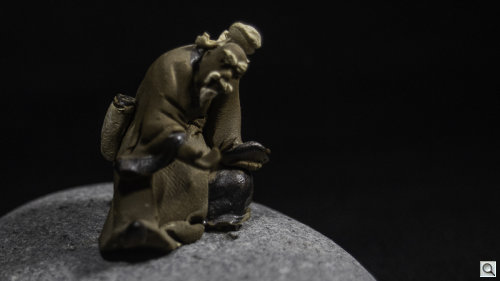Photo Corners headlinesarchivemikepasini.com
![]()
A S C R A P B O O K O F S O L U T I O N S F O R T H E P H O T O G R A P H E R
![]()
Enhancing the enjoyment of taking pictures with news that matters, features that entertain and images that delight. Published frequently.
Friday Slide Show: The Wisdom of Old Men



25 February 2022
A long time ago Joyce gave us this little clay figure resting on a river stone. We see him as a wise old man expounding on the adventure of life's long winding road. He has sat on the shelf of a small desk we made in 1982 for my DEC Rainbow 100, one of the earliest personal computers.
That shelf was about six inches above the table top then. That was just the right elevation to get the VT-100 monitor to eye level. Later, for one glorious weekend, a Macintosh SE sat on it.
The shelf was elevated in 1998 to a height of 20 inches when we brought home a 17-inch CRT color monitor for our Power Macintosh 7300/200. The monitor sat underneath it (and still does, in fact).
So in a sense, the clay figure has ascended to new heights over the years.
And we have seen a lot of computers come and go under our fingertips. Our first was an IBM using magnetic tape, which provided a recording but, like any tape, could only be accessed sequentially. We were absolutely thrilled by the introduction of random-access floppy disks. But those were typesetting machines.
The Rainbow was our first personal computer. We bought four programs for it. A telecommunications program so it could communicate over a modem or an RS-232 cable, a spreadsheet from Microsoft called Multiplan, a word processor called WordStar and a database program called dBASE II from Ashton-Tate.
Those were the days.
We had never used a telecommunications or database program but we knew what a spreadsheet looked like and we'd been word processing on the typesetting equipment. We had some learning to do.
Apart from writing some elaborate regexes for typesetting, we had no experience writing code. But we happened to know two Bill Smiths. It took two to get us rolling, too.
The first Bill Smith was a pioneer at Fireman's Fund, advocating standardized forms for the insurance industry. The second Bill Smith worked for him, writing software. One day the first Bill invited us up the hill to Fireman's Fund to introduce us to the second Bill.
He loaned the second Bill to us for an afternoon. We had been trying to figure out how to print an invoice from the database.
Bill sat down at the keyboard and pecked away all afternoon, making mistake after mistake until, near the end of the day, we had an invoice program.
That's how you do it. Mistake after mistake.
We religiously followed his example for decades after that, learning to write in dBASE and converting those programs into C, which led to a suite of office automation products for the publishing industry. Our early interest in text processing led us into image processing. Before we were done, we had put together a magazine production system linking QuarkXPress to the Compugraphic MCS.

Old Man. In his usual place on that shelf.
Then we discovered HTML and the Web and suddenly in 1995 we were publishing those QuarkXPress files on the Internet.
Our early exploration of image processing using a scanner plus some photojournalism under the wing of Bill Harvey (another Bill) had primed us for the introduction of the digital camera. We jumped on those at the start, reviewing four models for the publication we inhabited. That led to 13 years editing a biweekly newsletter on the subject (with no images at all). Which led to Photo Corners (where images abound).
Looking back, we have to admit it was easier to raise the shelf on the old computer table. But not as much fun as making all those mistakes. Every one of which we had the satisfying pleasure of fixing.
